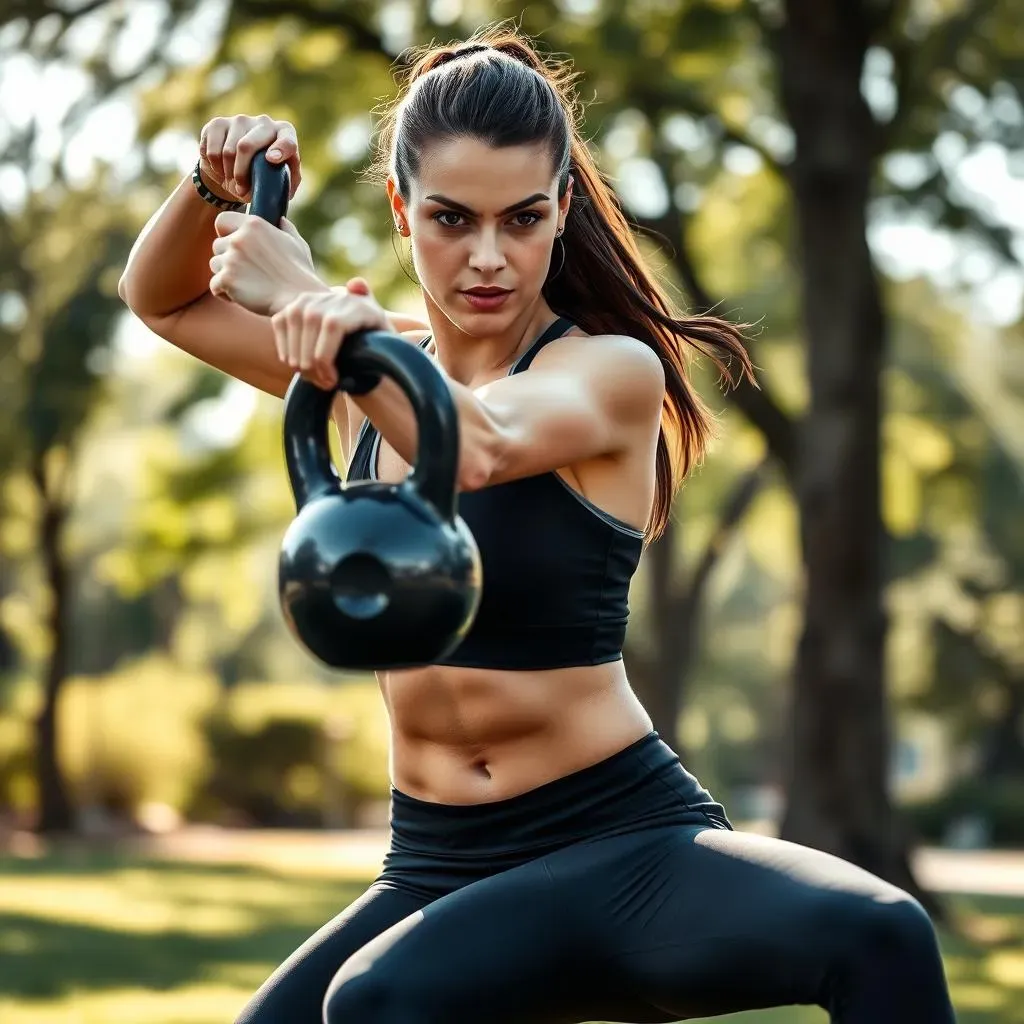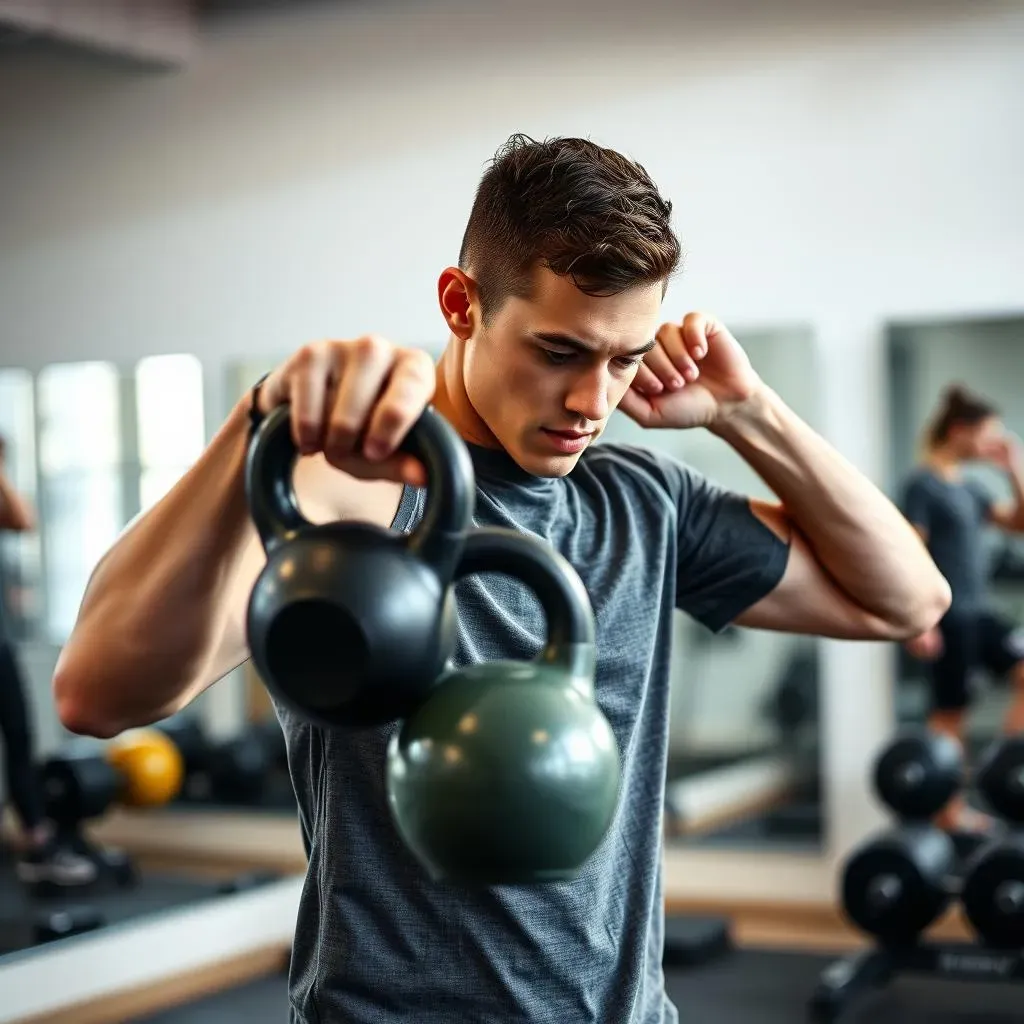Table of Contents
Ready to sculpt stronger legs and fire up your metabolism? Forget endless hours on the treadmill; the secret weapon you need is a kettlebell. This isn't just another fitness fad. A solid kettlebell leg routine can transform your lower body, building strength, power, and endurance you never thought possible. Kettlebells offer a unique advantage over traditional dumbbells, engaging your core more intensely and improving your balance and coordination. Think of it as functional fitness that translates directly into real-world strength.
Kettlebell Training Basics: Why Kettlebells for Legs?

Kettlebell Training Basics: Why Kettlebells for Legs?
More Than Just a Weight: The Kettlebell Difference
so you're thinking about leg day. Barbells, dumbbells, machines – you've seen it all. But have you truly considered the kettlebell? These cannonball-shaped weights with handles aren't just some trendy fitness tool. They offer a unique training stimulus that can seriously level up your leg workouts. It's all about the offset center of gravity.
That uneven weight distribution forces your muscles to work harder to stabilize and control the kettlebell throughout each movement. This translates to increased core engagement, improved balance, and enhanced functional strength – meaning you're not just building muscle, you're building real-world power.
Unlocking Functional Strength and Stability
Think about everyday movements: picking up groceries, climbing stairs, or even just maintaining good posture. These actions require a combination of strength, stability, and coordination. Kettlebell exercises mimic these real-life movements, training your muscles to work together as a cohesive unit. This is especially beneficial for your legs, which are the foundation of so many functional activities.
Plus, many kettlebell exercises are unilateral, meaning they work one leg at a time. This helps to identify and correct muscle imbalances, improving your overall stability and reducing your risk of injury. Ever notice one leg feels stronger than the other? Kettlebells can help even things out.
Core Activation: The Unsung Hero of Kettlebell Leg Workouts
Here's a secret weapon: kettlebell leg exercises are secretly core exercises in disguise. Seriously, every swing, squat, and lunge requires significant core engagement to maintain proper form and control the weight. This constant core activation not only strengthens your abs and lower back but also improves your posture and protects your spine.
Compare this to a traditional barbell squat, where the weight is evenly distributed across your shoulders. While squats are great, kettlebells demand more from your core, leading to a more well-rounded and functional workout. So, if you want legs of steel and a core of iron, kettlebells are your new best friend.
Benefit | Description |
|---|---|
Enhanced Core Engagement | Offset weight forces constant core activation for stability. |
Improved Balance | Unilateral exercises highlight and correct muscle imbalances. |
Functional Strength | Mimics real-life movements, building practical power. |
12 Killer Kettlebell Leg Exercises for a Total Lower Body Burn

12 Killer Kettlebell Leg Exercises for a Total Lower Body Burn
Kettlebell Swings: The King of All Exercises
Alright, let's kick things off with the undisputed king of kettlebell exercises: the swing. Don't underestimate its simplicity; the kettlebell swing is a full-body powerhouse that seriously torches your hamstrings, glutes, and core. Think of it as a dynamic deadlift, but with momentum. The key is to hinge at your hips, not squat, driving the kettlebell forward with explosive power. Master the swing, and you've unlocked the foundation for so many other kettlebell movements.
I remember when I first started doing kettlebell swings, I was all arms and no hips. My lower back was screaming! But once I focused on that hip hinge and really engaged my glutes, everything clicked. It's a game-changer, trust me. You'll feel it in places you never knew existed.
Goblet Squat: Your New Best Friend
Next up, we've got the goblet squat. This is a fantastic exercise for building quad strength and improving squat depth. Hold the kettlebell close to your chest, like you're cradling a precious goblet (hence the name), and squat down as low as you can while maintaining good form. The kettlebell acts as a counterbalance, helping you stay upright and preventing you from tipping forward. It's a great way to learn proper squat mechanics and build serious leg strength.
Goblet squats are also awesome for beginners because they're relatively easy to learn and scale. Start with a lighter kettlebell and gradually increase the weight as you get stronger. Focus on keeping your chest up, your back straight, and your core engaged. And don't be afraid to experiment with different foot positions to find what feels most comfortable for you.
Bulgarian Split Squat: Embrace the Challenge
Now, let's crank up the intensity with the Bulgarian split squat. This is a unilateral exercise, meaning it works one leg at a time, which is fantastic for building stability and addressing muscle imbalances. Place your back foot on a bench or elevated surface, hold the kettlebell in front of your chest (or at your side for an extra challenge), and lower yourself down until your front thigh is parallel to the ground. This exercise is brutal, but the results are worth it.
The Bulgarian split squat targets your quads, glutes, and hamstrings, while also challenging your balance and core stability. It's a great way to build single-leg strength, which is essential for activities like running, jumping, and climbing stairs. Just be prepared for some serious muscle soreness the next day! Start with bodyweight if you need to, and gradually add weight as you get stronger.
Exercise | Muscles Targeted | Benefits |
|---|---|---|
Kettlebell Swing | Hamstrings, Glutes, Core | Full-body power, hip hinge development |
Goblet Squat | Quads, Glutes | Squat depth, front-loaded strength |
Bulgarian Split Squat | Quads, Glutes, Hamstrings | Unilateral strength, balance |
Crafting Your Kettlebell Leg Routine: Sets, Reps, and Progression

Crafting Your Kettlebell Leg Routine: Sets, Reps, and Progression
Finding Your Starting Point
so you're armed with a arsenal of kettlebell exercises. Now what? Jumping in without a plan is like driving cross-country without a map – you might get somewhere, but it probably won't be where you intended. The key to a successful kettlebell leg routine is to start with a realistic assessment of your current fitness level. Can you comfortably squat with just your body weight? Have you ever swung a kettlebell before? Be honest with yourself; there's no shame in starting small.
If you're a complete beginner, focus on mastering the fundamental movements first. Start with bodyweight squats, lunges, and planks to build a solid foundation. Then, gradually introduce light kettlebells, focusing on proper form and technique. Remember, it's better to start too light than too heavy. You can always increase the weight as you get stronger. Think of it as building a house: you need a strong foundation before you can start adding the walls and roof.
Designing Your Workout: Sets, Reps, and Rest
Once you've got the basics down, it's time to start designing your kettlebell leg routine. There's no one-size-fits-all approach, but here are some general guidelines to get you started. For building strength and muscle, aim for 3-4 sets of 8-12 reps per exercise. For building endurance, you can increase the reps to 15-20 per set. And for explosive power, try lower reps (5-8) with heavier weight, focusing on generating maximum force with each movement.
Rest is just as important as the exercises themselves. Give your muscles adequate time to recover between sets, typically 60-90 seconds for strength training and 30-60 seconds for endurance training. And don't forget to listen to your body. If you're feeling pain, stop and rest. Pushing through pain can lead to injuries that will set you back in the long run. Remember, consistency is key, so find a routine that you can stick with over the long haul.
Goal | Sets | Reps | Rest |
|---|---|---|---|
Strength | 3-4 | 8-12 | 60-90 seconds |
Endurance | 3-4 | 15-20 | 30-60 seconds |
Power | 3-5 | 5-8 | 2-3 minutes |
Safety First: Tips for a Solid Kettlebell Leg Workout

Safety First: Tips for a Solid Kettlebell Leg Workout
Master the Fundamentals Before Adding Weight
Look, I get it. You're excited to swing that kettlebell and build some serious leg muscle. But trust me on this one: mastering the fundamentals is non-negotiable. Before you even think about adding weight, make sure you've nailed the proper form for each exercise. This means understanding the correct hip hinge for swings, maintaining a straight back during squats, and keeping your core engaged throughout every movement. Think of it like learning to drive a car: you wouldn't jump straight into a race without first learning how to steer and brake, would you?
Poor form not only reduces the effectiveness of the exercise but also significantly increases your risk of injury. I've seen so many people get sidelined by back pain or knee problems because they rushed into things without building a solid foundation. Take your time, practice in front of a mirror, and even consider working with a qualified trainer to get personalized feedback. Your body will thank you in the long run.
Listen to Your Body and Respect Its Limits
This might sound like a cliché, but it's one of the most important pieces of advice I can give you. Your body is an incredibly sophisticated machine, and it's constantly sending you signals about its condition. Learn to listen to those signals and respect your limits. If you're feeling pain, don't push through it. Stop, rest, and assess the situation. Is it just muscle soreness, or is it something more serious? Don't be afraid to modify the exercise or even skip it altogether if necessary.
Overtraining is a real thing, and it can lead to a whole host of problems, including fatigue, muscle imbalances, and increased risk of injury. Make sure you're getting enough rest and recovery between workouts, and don't be afraid to take a day off when you need it. Remember, fitness is a marathon, not a sprint. The goal is to build a sustainable routine that you can stick with for the long haul, not to burn yourself out in a few weeks. Respect your body, and it will reward you with strength, health, and longevity.
Safety Tip | Description |
|---|---|
Master Fundamentals | Perfect form before adding weight. |
Listen to Your Body | Respect limits, don't push through pain. |
Proper Warm-up | Prepare muscles and joints for exercise. |
Elevate Your Leg Day: The Kettlebell Advantage
So, there you have it – a comprehensive guide to building a powerful and effective kettlebell leg routine. Integrating these 12 exercises into your fitness plan will not only sculpt your quads, hamstrings, and calves but also enhance your overall functional strength and core stability. Remember to prioritize proper form, gradually increase the weight, and listen to your body. Kettlebells offer a dynamic and engaging way to challenge your muscles and achieve remarkable results. It's time to ditch the monotony of traditional leg workouts and embrace the kettlebell revolution for a stronger, more resilient lower body.